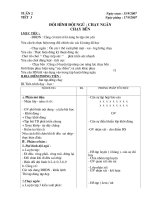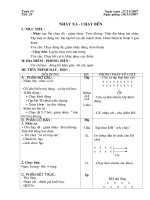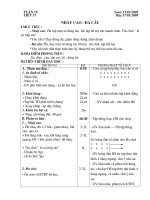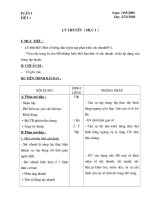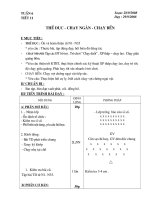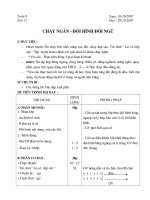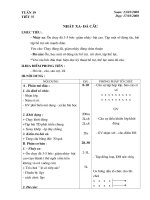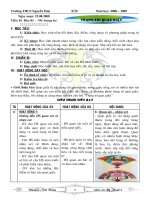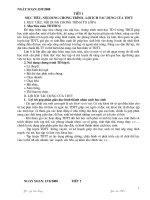Giáo án mới cả năm
Bạn đang xem bản rút gọn của tài liệu. Xem và tải ngay bản đầy đủ của tài liệu tại đây (517.22 KB, 24 trang )
<span class='text_page_counter'>(1)</span><div class='page_container' data-page=1>
<b>WEEK:1</b> <b> Preparing date: \</b>
<b>Period: 1 </b> Teaching date: \
<b>INTRODUCION ABOUT ENGLISH 6</b>
<b>I./. OBJECTIVE: - Helps Sts understand something about country and people in England.</b>
- Helps Sts understand sth about English and have the way to learn English.
<b>1. Knowledge</b>
<b>2. Skills: Practicing skills</b>
<b>3. Attitude: </b>
- Students know how to learn English in right way.
- Ss are interested in doing exercises.
<b>4. Competences:</b>
- Co-operation
- Self- study
- Using language to do exercises
<b>II./.PREPARATION:</b>
<b>1.Teacher: book, planning, picture, laptop, projector</b>
<b>2.Students: books, notebooks</b>
<b>III./. TEACHING METHODS: discussion group, technical present….</b>
<b>III./.PROCEDURE:</b>
Sts and T’s activities Contents
<b>1. warm up.</b>
- T. gives a picture and asks sts “Where
is it”
- sts look at the picture and guess
<b>2. Presentation </b>
T. asks sts some questions about
England.
- What do you know about England?
T. gives sts something about England and
English.
<b>3. Introduce new book. </b>
* T. introduces the book to Ss.
<b>-4. Further practice</b>
T. gives some pictures to introduce them
with sts.
- Picture about London (Big Ben picture)
- Sts answer: It’s in London in England.
- It located in North-west coast of
Europe with very mild weather not too
hot but not too cold.
- It consists of four parts: England,
Wales, Scotland and Ireland.
- It’s official name is the UK
- Each part has its own flag of UK.
- There are many interesting things of
England and you’ll gradually know
about them in the progress of learning
English.
- English 6 has 12 Units. Each unit has 7
lessons.
</div>
<span class='text_page_counter'>(2)</span><div class='page_container' data-page=2>
<b>5. Production</b>
Prepare Unit 1 (Getting started)
+ Lesson 4: Communication
+ Lesson 5: Skills 1
+ Lesson 6: Skills 2
+ Lesson 7: Looking back and project
- Ss can practice all 4 skills
- English is not too difficult but it
requires you working hard.
- Sts need learn by heart all vocabulary
and their usage.
- Review the lesson everyday.
- Learn English everyday.
<b>---0@0---WEEK:1</b> <b> </b> <b> Preparing date: 15/ 8/ </b>
<b>Period: 2 </b> Teaching date: 21/ 8/
<b>UNIT 1: MY NEW SCHOOL</b>
<b>Lesson 1: Getting started</b>
<b>I./. OBJECTIVE: By the end of the lesson, students can:</b>
- use the lexical items related to the school things.
- Use the combinations: to have + noun.
- Ask appropriate questions when making new friends at a new school.
<b>1. Knowledge: Vocabulary: calculator, compass, pencil sharpener, …..</b>
- Structure: appropriate questions when making new friends at a new school.
<b>2. Skills: Practicing skills</b>
<b>3. Attitude: - Positive about the school</b>
- Students know how to learn English in right way.
- Ss are interested in doing exercises.
- Ss are interested in and proud of the school
<b>4. Competences:</b>
- Co-operation
- Self- study
- Using language to talk about the school.
<b>II./.PREPARATION:</b>
<b>1.Teacher: book, planning, picture, laptop, projector</b>
<b>2.Students: books, notebooks</b>
<b>III./. TEACHING METHODS: Communicative approach, group Ss and T’s activities, </b>
play as a character, teaching methods with game, teaching methods by visual, teaching
methods by practising, discussion group, technical present….
<b>III./.PROCEDURE:</b>
Sts and T’s activities Contents
<b>1. Warm up.</b>
</div>
<span class='text_page_counter'>(3)</span><div class='page_container' data-page=3>
themselves.
<b>2. Getting - started</b>
* Pre-teach:
- T. uses picture and elicits words
- explanation
Rub out and remember.
* A special day.
- T. hangs the picture (on Page 8) and write
the title on the board “ A special day”.
- T. explains the meaning of “special” and
asks sts to guess what the picture might
show or what the conversation might be
about.
- Then check their answers.
* Listen and read
T. plays the record and asks sts to listen to
the conversation and read carefully. Then do
exercises:
a) Are these sentences true (T) or false (F)?
b) Find these expressions in the
conversation. Check what they mean.
Example:
T. What’s your name?
St 1: My name is ……….
T. How old are you?
St1: I’m ……….
T. Where are you from?
St1: I’m from ……….
……….
<b>1. Listen and read (P6)</b>
* Vocabulary
- (to) wear (v) : mặc
- uniform (n) : đồng phục
- pencil sharpener (n) : Gọt bút chì
- calculator (n) : máy tính
- compass (n) : com pa
- smart (Adj): thông minh
- (to) be excited about : hồi hộp, hào hứng
Eg.
I am very excited about our first day at
school.
* Ss look at the picture and guess what the
picture might show about and what the
conversation might be about.
T. asks Ss some questions about the
picture.
T: What is Phong doing?
St1: Phong is having breakfast.
T: Who are Vy and Duy?
St2: ………
T; Why it is a special day?
……….
- Listen the conversation, then read
a) Are these sentences true (T) or false (F)?
1. Vy and Duy are early.
2. Phong is eating.
3. Duy is Phong’s friend.
4. Duy lives near Phong
5. Phong is wearing a school uniform.
Answer key.
</div>
<span class='text_page_counter'>(4)</span><div class='page_container' data-page=4>
c) Sts work in pairs. Create short role plays
with the expressions.
<b>3.Doing. </b>
- T. lets Ss listen to the poem on P7.
- Ss listen to the poem and work in pairs to
write a poem about their partner.
- T. calls two or three sts on the board and
read their poem aloud.
T. asks Ss to match the words with the
picture on P 7.
Ss listen and repeat.
<b>4. Further practice</b>
T. divides class into 6 group and asks them
to draw the things they have in the
classroom.
Ss draw picture in their notebook.
<b>5. Production</b>
conversation. Check what they mean.
1. Oh dear: Used to express
surprise(negative)
2. You’ll see = ‘You’ll find out’
3. Come in : used to invite sbd in
4. Sure : used to say ‘Yes’/ alright
c) Create short role plays with the
expressions.
<b>2. Listen and read the following poem. </b>
(P7)
* Write a poem about their partner
Eg. Minh is going back to school today.
His friends are going back to school, to.
His new school year starts today.
He’s got a new schoolbag.
He’s got a new bike.
……….
<b>3. Match the words with the school </b>
<b>things. Then listen and repeat.</b>
Matching.
1. pencil sharpener
2. compass
3. schoolbag
4. rubber
5. calculator
6. pencil case
7. notebook
8. bicycle
9. ruler
10.textbook
<b>4. Look around the class- what other </b>
<b>things do you have in your classroom? </b>
- Learn by heart Vocabulary.
- Prepare “A closer look 1”.
<b>---0@0---WEEK:1</b> <b> </b> <b> Preparing date: 16/ 8/ </b>
<b>Period: 3 </b> Teaching date: 24/ 8/
</div>
<span class='text_page_counter'>(5)</span><div class='page_container' data-page=5>
<b>Lesson 2: A CLOSER LOOK 1</b>
<b>I./. OBJECTIVE: By the end of the lesson, students can:</b>
- Pronounce correctly the sounds
/
əʊ/
and/
ʌ/
in isolation and in context.- use the lexical items related to the topic “My New School”
- Use the combinations: to have, to do, to study, to play + noun.
- Ask appropriate questions when making new friends at a new school.
<b>1. Knowledge: Vocabulary: calculator, compass, pencil sharpener, …..</b>
- Structure: appropriate questions when making new friends at a new school.
<b>2. Skills: Practicing skills</b>
<b>3. Attitude: - Positive about the school</b>
- Students know how to learn English in right way.
- Ss are interested in doing exercises.
- Ss are interested in and proud of the school
<b>4. Competences:- Co-operation, self- study, using language…</b>
<b>II./.PREPARATION:</b>
<b>1.Teacher: book, planning, picture, laptop, projector</b>
<b>2.Students: books, notebooks</b>
<b>III./. TEACHING METHODS: Communicative, game, practising, discussion group, </b>
technical present….
<b>III./.PROCEDURE:</b>
math
music
timetable
geography
literatu
re
history
English
Sts and T’s activities Contents
<b>1. Warm up</b>
Play a game: “Slap the board” to
remember the words about subjects at
school
T. divides class into two groups
- Each group chooses 4 students to take
part in the game.
- two teams stand in lines
- T. reads word in Vietnamese
- the two first Ss run quickly and slap the
word in English on the board
- The winner is the person slap first.
- The loser has to come back his seat.
<b>2. Vocabulary</b>
* Vocabulary
T. elicits Voc by using pictures or real
items.
- listen and repeat.
Rub out and remember.
T. calls a student to the board and rewrite
al the words in English.
“Slap the board”
1. Vocabulary
Physics /’fɪz.ɪks/ (N) : mụn vật lý
Lesson /’les. ə n/ (N) : bài học
Science /saɪən t s/ (N) : mụn khoa học
homework /’həʊm.wɜ:k/(N) bài tập về nhà
exercises /’ek.sə.saɪz/ (N) : bài tập
Judo /;dʒu.dəʊ/ (N) : mụn vừ judo
School lunch /sku:l lʌn t ʃ/ (N) bữa trưa ở
</div>
<span class='text_page_counter'>(6)</span><div class='page_container' data-page=6>
<b>---0@0---WEEK:2</b> <b> </b> <b> Preparing date: 21/ 8/ </b>
<b>Period: 4 </b> Teaching date: 27/ 8/
<b>UNIT 1: MY NEW SCHOOL</b>
<b>Lesson 3: A closer look 2</b>
<b>I./. OBJECTIVE: By the end of the lesson, students can:</b>
- Use the present simple and the present continuous.
- Use the present simple verbs with the third singular subject in the positive,
negative and questions.
- Talk about school activities, subjects and what Ss do at school.
- Listen to get information about school activities.
- Read for specific information about schools, and read e-mails and web
- Ask appropriate questions when making new friends at a new school.
<b>1. Knowledge: Vocabulary: calculator, compass, pencil sharpener, …..</b>
- Structure: appropriate questions when making new friends at a new school.
<b>2. Skills: Practicing skills</b>
<b>3. Attitude: - Positive about the school</b>
- Students know how to learn English in right way.
- Ss are interested in doing exercises.
- Ss are interested in and proud of the school
<b>4. Competences:</b>
- Co-operation
- Self- study
- Using language to talk about the school.
<b>II./.PREPARATION:</b>
<b>1.Teacher: book, planning, picture, laptop, projector</b>
<b>2.Students: books, notebooks</b>
<b>III./. TEACHING METHODS: Communicative approach, group Ss and T’s activities, </b>
play as a character, teaching methods with game, teaching methods by visual, teaching
methods by practising, discussion group, technical present….
<b>III./.PROCEDURE:</b>
Sts and T’s activities Contents
<b>1. Warm up</b>
Play a game: “Lucky number” to
remember the verbs and noun in the last
lesson.
- divides class into two group
- Ss choose the number they like and make
sentence with the word they see from that
number.
1. Lucky number
2. play/ football
3. have/ lessons
</div>
<span class='text_page_counter'>(7)</span><div class='page_container' data-page=7>
4. do / housework
5. Lucky number
6. study / English
7. play / music
8. study / vocabulary
- two marks for each correct answer.
* Vocabulary
T. elicits Voc by using pictures or real
items.
- listen and repeat.
Rub out and remember.
T. calls a student to the board and rewrite
al the words in English.
<b>2. Grammar 1</b>
- T. give some example and explain how to
use the verbs in the present simple tense.
1. Lucky number
2. I play football every afternoon
3. We have lessons in the morning
4. Nam does the housework
5. Lucky number
6. I study English
7. We play music on Sunday
8. I study vocabulary everyday
* Vocabulary
- playground /ˈpleɪ.graʊnd/ : sân chơi
- walk /wɔːk/ : đi bộ
- ride /raɪd/ : đi (xe đạp)
- teach /tiːtʃ/ : dạy
- read /riːd/ : đọc
- break time /breɪk taɪm / : giờ giải lao
* Grammar
a) The Present simple
- Example.
1. Philip gets up at 6 o'clock every morning.
2. I go to school every day.
3. She sometimes goes out on Friday night.
4. I usually play football in the afternoon.
- Usage.
We use the present simple tense when:
the action is general
the action happens all the time, or
habitually, in the past, present and future
the action is not only happening now
the statement is always true
- Form
Positive:
Affirmative form
<i>I</i>
<i>you work</i>
<i>we </i>
<i>they</i>
<i>he/she/it works /-s/</i>
<i>go - goes /-es/</i>
</div>
<span class='text_page_counter'>(8)</span><div class='page_container' data-page=8>
Task 1.
- Ss do the task 1 individually (in 3 ms)
- T. calls some Ss to say their answers
separately.
- T. gives explanation
Task 2.
- Ss work in pairs.
- T calls some pairs to role play the
interview before class.
Task 3.
<i>play - plays /-s/</i>
<i>study - studies /-es/</i>
<b>! Remember:</b>
<b>to be</b>
I/you/we/they are
he/she/it is
<b>to do</b>
I/you/we/they do
he/she/it does
<b>to have</b>
I/you/we/they have
he/she/it has
Negative form
I
you DO NOT /don't/ WORK
we
they
he/she/it DOES NOT/doesn't / WORK
1. She doesn't often go to the cinema.
2. I don't get up early at the weekend.
3. They don't speak English very well.
Interrogative form
I
DO you WORK?
we
they
DOES he/she/it WORK?
1. Do they speak foreign languages?
2. Do you want a banana?
3. Does your sister play the piano?
+ Answer key for task 1 P 9
1. has 2. Do you have
3. love 4. Does Vy walk
5. ride 6. teaches
7. doesn’t play 8. reads
9. go 10 do
</div>
<span class='text_page_counter'>(9)</span><div class='page_container' data-page=9>
T. lets Ss write the sentences in their
notebooks.
T. call two or three students to write on the
board and correct.
Task 4. Work in pairs.
T. asks Ss to make questions and then
interview their friends.
<b>3. Grammar 2</b>
Task 5. Ss listen to the tape and underline
the present continuous form.
Task 6. Ss work in groups (with 4 Ss)
<b>4. Further practice</b>
T. explains the differences between the two
tense.
Ss do task 7.
Task 8. T has Ss do the task by themselves.
Then let them discuss their answers.
<b>5. Production</b>
+ Answer key.
1. Duy lives near here
2. Duy likes/loves his new school
3. Vy and Duy ride bike to school
4. Mr Quang teaches Duy English.
5. At break time, Phong reads in the
library.
- T. helps Ss to make questions and give the
answers.
1. Do you ride your bicycle to school?
2. Do you read in the library at break time?
3. Do you like your new school?
4. Do your friends go to school with you?
5. Do you do your homework after school?
- Listen to part of the conversation from
getting started again. Then find and
underline the present continuous form
- Complete the sentences with the correct
form of the verbs.
Answer key:
1. am not playing 2. are studying
3. aren’t doing 4. am having
5. are riding
- Choose the correct tense of the verbs.
Answer key:
1. are having 2. wears
3. starts 4. is watching
5. are skipping
Ss read and compare Vy’s first week with
themselves
- Learn by heart Vocabulary.
- Prepare “Communication”
</div>
<span class='text_page_counter'>(10)</span><div class='page_container' data-page=10>
<b>UNIT 1: MY NEW SCHOOL</b>
<b>Lesson 4: Communication</b>
<b>I./ OBJECTIVE: By the end of the lesson, students can:</b>
- Talk about school activities, subjects and what Ss do at school.
- Listen to get information about school activities.
- Talk about their friends
- Give nice sentences about friendship
<b>1. Knowledge: Vocabulary: calculator, compass, pencil sharpener, …..</b>
- Structure: appropriate questions when making new friends at a new school.
<b>2. Skills: Practicing skills</b>
<b>3. Attitude: - Positive about the school</b>
- Students know how to learn English in right way.
- Ss are interested in doing exercises.
- Ss are interested in and proud of the school
<b>4. Competences:</b>
- Co-operation
- Self- study
- Using language to talk about the school.
<b>II./.PREPARATION:</b>
<b>1.Teacher: book, planning, picture, laptop, projector</b>
<b>2.Students: books, notebooks</b>
<b>III./. TEACHING METHODS: Communicative approach, group Ss and T’s activities, </b>
play as a character, teaching methods with game, teaching methods by visual, teaching
methods by practising, discussion group, technical present….
<b>III./.PROCEDURE:</b>
Sts and T’s activities Contents
<b> 1.Warm up</b>
T. Lets Ss watch a video clip about
“making friend”
<b>2. Communication 1:</b>
* Vocabulary
T. elicits Voc by using pictures or real
items.
- listen and repeat.
Rub out and remember.
T. calls a student to the board and rewrite
al the words in English.
Watch a video clip.
* Vocabulary
</div>
<span class='text_page_counter'>(11)</span><div class='page_container' data-page=11>
* T. asks Ss how they often make
friends, what they often say when they
first meet a new friend….
T. introduce the rules of the game.
Task 1
- Ss work in groups to ask their friends
with the question on P 11. and tick the
questions that they think are suitable to
ask a new friend at school.
- Ss have 5 minutes to write questions on
a peace of paper, share them with the
class.
<b>3. Communication 2:</b>
Task 2.
a) T. divides class into 6 groups
Ss practice, ask and give the answers
with Yes/no.
b) - Ss use the questions and give nice
sentences about friendship.
<b>4. Further practice;</b>
T. calls some Ss to the board and present
* Listen to the teacher and answer the T’s
questions.
Example:
T: How do you make friends? When you make
friend, what questions do you ask first?
S1: I ask: name, age, address….
………..
Play game: Making friends
Read and tick (√) the question you think are
suitable to ask a new friend at school
Ss share question with their friends.
1. Are you from around here?
2. Do you like pop music?
3. How much pocket money do you get?
4. What is your favorite subject at school?
5. Are you hungry?
6. Do you play football?
7. How do you get to school everyday?
8. Where do you go shopping?
Ss take turn to interview the other members,
using the questions.
1. Do you remember all your new classmates’
names?
2. Do you help your teacher in the class?
3. Do you share things with your classmates?
4. Do you keep quiet when your teacher is
talking?
5. Do you play with your classmates at break
time?
6. Do you help your classmates with their
homework?
7. Do you travel to school with your
classmates?
8. Do you listen when your classmates are
talking?
Example:
- “Friends are forever”
………….
</div>
<span class='text_page_counter'>(12)</span><div class='page_container' data-page=12>
to the class about their good friends.
<b>5. Production</b>
- Learn by heart Vocabulary.
- Prepare “Skill 1”
<b>---0@0---WEEK:2</b> <b> </b> <b> Preparing date: 25.8. </b>
<b>Period: 6 </b> Teaching date: 31.8.
<b>UNIT 1: MY NEW SCHOOL</b>
<b>Lesson 5: Skills 1</b>
<b>I./. OBJECTIVE: By the end of the lesson, students can:</b>
- Talk about school activities, subjects and what Ss do at school.
- Listen to get information about school activities.
- Talk about their friends
- Give nice sentences about friendship
<b>1. Knowledge: Vocabulary: calculator, compass, pencil sharpener, …..</b>
- Structure: appropriate questions when making new friends at a new school.
<b>2. Skills: Practicing skills</b>
<b>3. Attitude: - Positive about the school</b>
- Students know how to learn English in right way.
- Ss are interested in doing exercises.
- Ss are interested in and proud of the school
<b>4. Competences:</b>
- Co-operation
- Self- study
- Using language to talk about the school.
<b>II./PREPARATION:</b>
<b>1.Teacher: book, planning, picture, laptop, projector</b>
<b>2.Students: books, notebooks</b>
<b>III./ TEACHING METHODS: Communicative approach, group Ss and T’s activities,</b>
play as a character, teaching methods with game, teaching methods by visual, teaching
methods by practising, discussion group, technical present….
<b>III./.PROCEDURE:</b>
Sts and T’s activities Contents
<b>1.Warm up</b>
T. Lets Ss look at the three picture on page
12. then encourages Ss to give their ideas.
<b>2. Reading:</b>
* Vocabulary
T. elicits Voc by using pictures or real
items.
Ss look at the three pictures and give the
ideas.
Suggestion:
- The first picture is about ……….
- The second picture ………
- The third picture ………
* Vocabulary
</div>
<span class='text_page_counter'>(13)</span><div class='page_container' data-page=13>
- listen and repeat.
Rub out and remember.
T. calls a student to the board and rewrite
al the words in English.
* Pre-reading.
T. gives some question about the texts and
asks Ss to read and give the answer by take
note the information from the texts.
Task 1
- Ss work in groups
- Read the text and take note.
Task 2.
Ss work in pairs to find the meaning of the
words in the text
Ss practice and give the meaning of the
words.
Task 3
Ss work in group of 4
<b>3. Speaking:</b>
trú
- college ['kɔlidʒ]: Trường đại học
- surround [sə'raund]: bao quanh
- field [fi:ld]: cánh đồng
- equipment [i'kwipmənt]: trang thiết bị
- modern ['mɔdən] : hiện đại
- creative [kri:'eitiv] : sang tạo
- international [,intə'næ∫ənl]: Quốc tế
* Question comprehension;
a. Where is PLC school?
b. How many students are there in PLC?
c. How is An Lac school?
d. What is there in An Lac School?
e. What is Vinabrita school?
f. What do the students do at Vinabrita
school?
<b>1. Read the text quickly to check ideas</b>
a. PLC is in Sydney
b. there are about 1,250 students
c. It is a small school with 7 classes.
d. there is a computer room, a library, a
school garden and a playground.
e. It is an international school for Ss from
year 1 to year 12.
f. Ss learn and joy many interesting clubs,
they play sports, do drawings and painting.
<b>2. Find the meaning of the words in the </b>
<b>text.</b>
- boarding school is a school where students
live and study
- surrounded: to be everywhere around
something
- international: involving more than one
country
- creative: producing or using original and
unusual ideas
<b>3. Read the text again and complete the </b>
<b>sentences on P 12.</b>
Answer key.
</div>
<span class='text_page_counter'>(14)</span><div class='page_container' data-page=14>
Task 4
T. asks Ss to practice in groups, discuss
and choose the school they like to go to.
<b>4. Further practice</b>
<b>5. Production</b>
5. English speaking teachers
4. Speaking.
Discuss and choose the school they like.
Name of school Reasons you like
it Reasons youdon’t like it
- talk again
- Learn by heart Vocabulary.
- Prepare “Skill 2”
<b>---0@0---WEEK:3</b> <b> </b> <b> Preparing date: 26.8. </b>
<b>Period: 7 </b> Teaching date: 4. 9.
<b>UNIT 1: MY NEW SCHOOL</b>
<b>Lesson 6: SKIILS 2</b>
<b>I./. OBJECTIVE: By the end of the lesson, students can:</b>
- Talk about school activities, subjects and what Ss do at school.
- Listen to get information about school activities.
- Talk about their friends
- Give nice sentences about friendship
- Read for specific information about schools, and write e-mails and web pages.
<b>1. Knowledge: Vocabulary: calculator, compass, pencil sharpener, …..</b>
- Structure: appropriate questions when making new friends at a new school.
<b>2. Skills: Practicing skills</b>
<b>3. Attitude: - Positive about the school</b>
- Students know how to learn English in right way.
- Ss are interested in doing exercises.
</div>
<span class='text_page_counter'>(15)</span><div class='page_container' data-page=15>
<b>4. Competence and quality:</b>
<i><b>4.1. Competence:</b></i>
<i>- General capacity:self-learning ability, communication capacity, capacity to use </i>
language, cooperation capacity,…
<i>- Specilized capacity:English language ability, develop self capacity,.. </i>
<i><b>4.2. Quality: Love family and country, willing to participate in social activities, live </b></i>
humanty, cooperate with people around,…
<b>II./.PREPARATION:</b>
<b>1.Teacher: book, planning, picture, laptop, projector</b>
<b>2.Students: books, notebooks</b>
<b>III./.PROCEDURE:</b>
Sts and T’s activities Contents
<b>1.Warm up</b>
Play a game: “Slap the board” to remember
the words in the last lesson.
<b>2. Listening;</b>
<b>-T- M: Play game, practising, discussion </b>
group, technical present….
<b>-C&Q: Co-operation,communication, </b>
self-study, using language…
* Pre listening.
T. asks some Ss some questions about 3
schools in the last lesson to elicit Ss
remember the information about those
schools.
* While listening.
Ss listen to the tape and choose the correct
answer.
<b>3. Writing:</b>
<b>-T- M: Play game, practising, discussion </b>
group, technical present….
<b>-C&Q: Co-operation,communication, </b>
self-study, using language…
* Pre writing
T. explains how to write a webpage for a
school
Play: “Slap the board”
* Question comprehension
a. Which school do you like to go?
b. Why do you like it?
<b>1. Listen and choose the correct answers</b>
1. A
2. A
3. B
4. B
5. A
<b> Write a passage for your school.</b>
While writing, Ss should remember:
- correct punctuation.
- Capital letters for: starting sentences,
name, days and months, the pronoun and
places
</div>
<span class='text_page_counter'>(16)</span><div class='page_container' data-page=16>
- Ss work in groups
- Read the text and take note.
Task 2
- Ss work in pairs.
T calls two Ss to the board and write their
answers
T. checks SS’ answers
Task 3
Ss work in groups
T calls two Ss to the board and write their
answers
T. checks SS’ answers
<b>4. Further practice</b>
<b>-T- M: Play game, practising, discussion </b>
group, technical present….
<b>-C&Q: Co-operation,communication, </b>
self-study, using language…
Task 4
T. asks Ss to practice in groups.
Ss write the answer on a draft first
Ss work in groups (6 groups) to write a
paragraph of about 80 words about their
school on a paper.
- Correct and give marks
<b>5. Production</b>
stops, question marks or exclamation
marks are put at the end of sentences
<b>2. Can you correct the punctuation in </b>
<b>these sentences?</b>
Answer key.
1. School starts in the 5th<sub> September.</sub>
2. Does he live in Ha Noi?
3. I’m excited about the first day of school.
4. Are you doing your homework?
5. We’re having an English lesson in class.
<b>3. Correct the passage.</b>
Answer key.
Hi, I’m Phong and I’m from Ho Chi Minh
City. I wear my uniform to school everyday.
My favorite teacher is Mr Trung. He teaches
me science.
<b>4. Create a webpage for your school.</b>
Ss brainstorm for the language necessary for
writing.
Ss write a paragraph of about 80 words
about their school, covering as many ideas
as possible of the answers to these questions.
- T. hangs the writing on the board and
correct one of them. Then give marks
- Learn by heart Vocabulary.
- Prepare “Looking back”
</div>
<span class='text_page_counter'>(17)</span><div class='page_container' data-page=17>
<b>UNIT 1: MY NEW SCHOOL</b>
<b>Lesson 7: Looking back and project</b>
<b>I./. OBJECTIVE: By the end of the lesson, students can:</b>
- use the lexical items related to the school things.
- Use the combinations: to have + noun.
- Ask appropriate questions when making new friends at a new school.
<b>1. Knowledge: Vocabulary: calculator, compass, pencil sharpener, …..</b>
- Structure: appropriate questions when making new friends at a new school.
<b>2. Skills: Practicing skills</b>
<b>3. Attitude: - Positive about the school</b>
- Students know how to learn English in right way.
- Ss are interested in doing exercises.
- Ss are interested in and proud of the school
<b>4. Competence and quality:</b>
<i><b>4.1. Competence:</b></i>
<i>- General capacity:self-learning ability, communication capacity, capacity to use </i>
language, cooperation capacity,…
<i>- Specilized capacity:English language ability, develop self capacity,.. </i>
<i><b>4.2. Quality: Love family and country, willing to participate in social activities, live </b></i>
humanty, cooperate with people around,…
<b>II./.PREPARATION:</b>
<b>1.Teacher: book, planning, picture, laptop, projector</b>
<b>2.Students: books, notebooks</b>
<b>III./.PROCEDURE:</b>
Sts and T’s activities Contents
<b>1.Warm up</b>
Play a game: “Matching” to remember the
words and the use of the verbs with nouns
in the last lesson.
- T. calls student A to the board and match
the word with the correct picture(E 1 P 14).
Answer key
a. dictionary b. calculator
c. notebook d. pencil sharpener
e. compass f. uniform
Matching
Match the word with the correct picture.
1. dictionary 2. rubber
3. compass 4. uniform
5. notebook 6. calculator
7. textbook 8. pencil sharpener
</div>
<span class='text_page_counter'>(18)</span><div class='page_container' data-page=18>
- T. calls student B to the board and match
the verbs with the nouns in exercise 2 P 14.
<b>2. Looking back:</b>
<b>-T- M: Play game, practising, discussion </b>
group, technical present….
<b>-C&Q: Co-operation,communication, </b>
self-study, using language…
Task 3. Listen.
- T. plays record and let Ss listen and
write the words in the correct places
- Ss listen to the tape and write the correct
answer.
Grammar
- Ss work in groups and do exercises
- T. calls Ss to read their answers
T. checks SS’ answers
- Ss work in groups and do exercises
- T. calls Ss to read their answers
T. checks SS’ answers
- Ss work in groups and do exercises
- T. calls Ss to read their answers
T. checks SS’ answers
Communication
- T. asks Ss to practice in groups to match
the questions with the correct answer.
d) e) f)
A B
1. study
2. do
3. play
4. have
a. the piano
b. Vietnamese
c. Exercises
d. breakfast
Listen and write down the words in the
correct places
Key.
1. play: sports, badminton, music
2. do: morning exercise, homework
3. study: new words, geography
4. have: English lessons, a new book
Grammar
<b>Task 4. complete the sentences with the</b>
<b>present simple.</b>
Answer key.
1. comes 4. do
2. don’t 5. teaches
3. walks 6. plays
<b>Task 5. complete the sentences with the</b>
<b>present continuous.</b>
Answer key.
1. are doing 4. is having
2. are riding 5. am walking
3. Is ___ studying 6. is teaching
<b>Task 6. complete the texts with the</b>
<b>correct form of the verb in brackets.</b>
Answer key.
1. lives 4. is walking
2. is 5. go
</div>
<span class='text_page_counter'>(19)</span><div class='page_container' data-page=19>
- role-play
Ss work in pairs and role-play the question
and answer
- Correct and give marks
<b>3. Project;</b>
<b>-T- M: Play game, practising, discussion </b>
group, technical present….
<b>-C&Q: Co-operation,communication, </b>
self-study, using language…
<b>4. Further practice</b>
<b>-T- M: Play game, practising, discussion </b>
group, technical present….
<b>-C&Q: Co-operation,communication, </b>
self-study, using language…
<b>5. Production</b>
<b>Task 7. Match the questions with the</b>
<b>correct answer.</b>
Answer key
b. How many class are there in your school?
g. sixteen.
d. How is your first week at school?
f. Oh, wonderful.
e. Does Mai live near her school?
a. Yes, she does.
h. What do you do in the evening?
c. I do my homework and watch TV at home
Task 8 Role-play the question and answer
- Learn by heart Vocabulary.
- Prepare “Looking back”
<b>---0@0---WEEK:3</b> <b> </b> <b> Preparing date: 1. 9. </b>
<b>Period: 9 </b> Teaching date: 8. 9.
<b>UNIT 2: MY HOME</b>
<b>Lesson 1: Getting started</b>
<b>I./. OBJECTIVE: By the end of the lesson, students can:</b>
- use the lexical items related to the topic “My home”.
- Use the prepositions of place.
- Ask about and describe houses, room and furniture.
<b>1. Knowledge: Vocabulary: name of the rooms of the house and the things in each rooms, </b>
….
<b>2. Skills: Practicing skills</b>
<b>3. Attitude: - Positive about houses</b>
- Students know how to learn English in right way.
- Ss are interested in doing exercises.
- Ss are interested in and proud of my house.
<b>4. Competence and quality:</b>
<i><b>4.1. Competence:</b></i>
<i>- General capacity:self-learning ability, communication capacity, capacity to use </i>
language, cooperation capacity,…
</div>
<span class='text_page_counter'>(20)</span><div class='page_container' data-page=20>
<i><b>4.2. Quality: Love family and country, willing to participate in social activities, live </b></i>
humanty, cooperate with people around,…
<b>II./.PREPARATION:</b>
<b>1.Teacher: book, planning, picture, laptop, projector</b>
<b>2.Students: books, notebooks</b>
<b>III./.PROCEDURE:</b>
Sts and T’s activities Contents
<b>1.Warm up</b>
T. shows the picture to Ss and asks them to
talk about the things in the picture.
Ss work in groups and discuss the picture.
- T. calls a student to the board and talk
about the position of the things in the
picture.
<b>2. Getting- started:</b>
<b>-T- M: Play game, practising, discussion </b>
group, technical present….
<b>-C&Q: Co-operation,communication, </b>
self-study, using language…
* Vocabulary.
T. uses picture and elicits words from Ss
Rub out and remember
<b>Task 1.</b>
T. show the picture on P16 and asks Ss what
two Ss in the picture are doing.
Ss guess and talk about the picture.
Ss listen to task 1. P 16 and work in pairs.
T. calls some pairs to read the dialogue
before class.
Ss do exercise part a. P 16.
T. corrects
What is the picture about?
* Vocabulary
In front of : đằng trước
Behind [ bi'haind]: Phía sau
Between [bi'twi:n] ở giữa
Next to bên cạnh
Under : ở dưới
(to) move : chuyển đi
Noisy : ồn ào
<b>1. Listen and read</b>
a) Which family members does Mi talk
about?
Grandparents
Dad √
Mum √
Brother √
Uncle
Aunt √
cousin √
b) Read the conversation again. Complete
the sentences.
</div>
<span class='text_page_counter'>(21)</span><div class='page_container' data-page=21>
Ss do exercise part a. P 16.
T. corrects
<b>3. Doing:</b>
<b>-T- M: Play game, practising, discussion </b>
group, technical present….
<b>-C&Q: Co-operation,communication, </b>
self-study, using language…
<b>Task 2.</b>
Prepositions of place.
T. asks Ss to work in pairs and match the
preposition with the pictures.
<b>Task 3. </b>
- T. asks Ss to write sentence.
T. calls one or two Ss to write on the board.
Then corrects
- Ss listen to the tape and write the correct
answer.
T. checks SS’ answers
<b>4. Further practice</b>
<b>-T- M: Play game, practising, discussion </b>
group, technical present….
<b>-C&Q: Co-operation,communication, </b>
self-study, using language…
- T. asks Ss to practice in groups to match
the questions with the correct answer.
T. asks Ss to work in groups and write the
answer on the papers.
T. corrects them.
- Correct and give marks
1. TV, sofa 2. town house
3. sitting on the sofa 4. noisy
5. three
<b>2. Match the preposition with the</b>
<b>pictures.</b>
A. on B. next to C. behind
D. in E. in front of F. between
G. under
<b>3. Write a sentence to describe each</b>
<b>picture.</b>
A. The dog is on the chair.
B. The dog is next to the bowl
C. The cat is behind the TV.
D. The cat is in the wardrobe.
E. The dog is in front of the kennel.
F. The cat is between the sofa and the lamp.
G. The cat is under the table.
<b>4. Look at the picture and write T or F</b>
<b>for each sentence. Correct the false ones.</b>
1. F The dog id between the bookshelf and
the bed.
2. T
3. F The clock is between the picture
4. F. The dog is in front of the kennel
5. F The cap is next to the pillow.
6. T
<b>5. Look at the picture again. Answer the </b>
<b>questions.</b>
Answer the question.
1. They are on the desk
2. they are on the floor
3. yes, it is
</div>
<span class='text_page_counter'>(22)</span><div class='page_container' data-page=22>
<b>5. Production</b> <sub>- Learn by heart Vocabulary.</sub>6. No, it isn’t. It’s next to the desk.
- Prepare “A closer look 1”
</div>
<!--links-->

